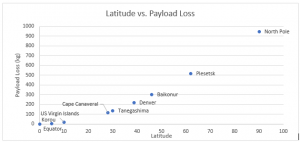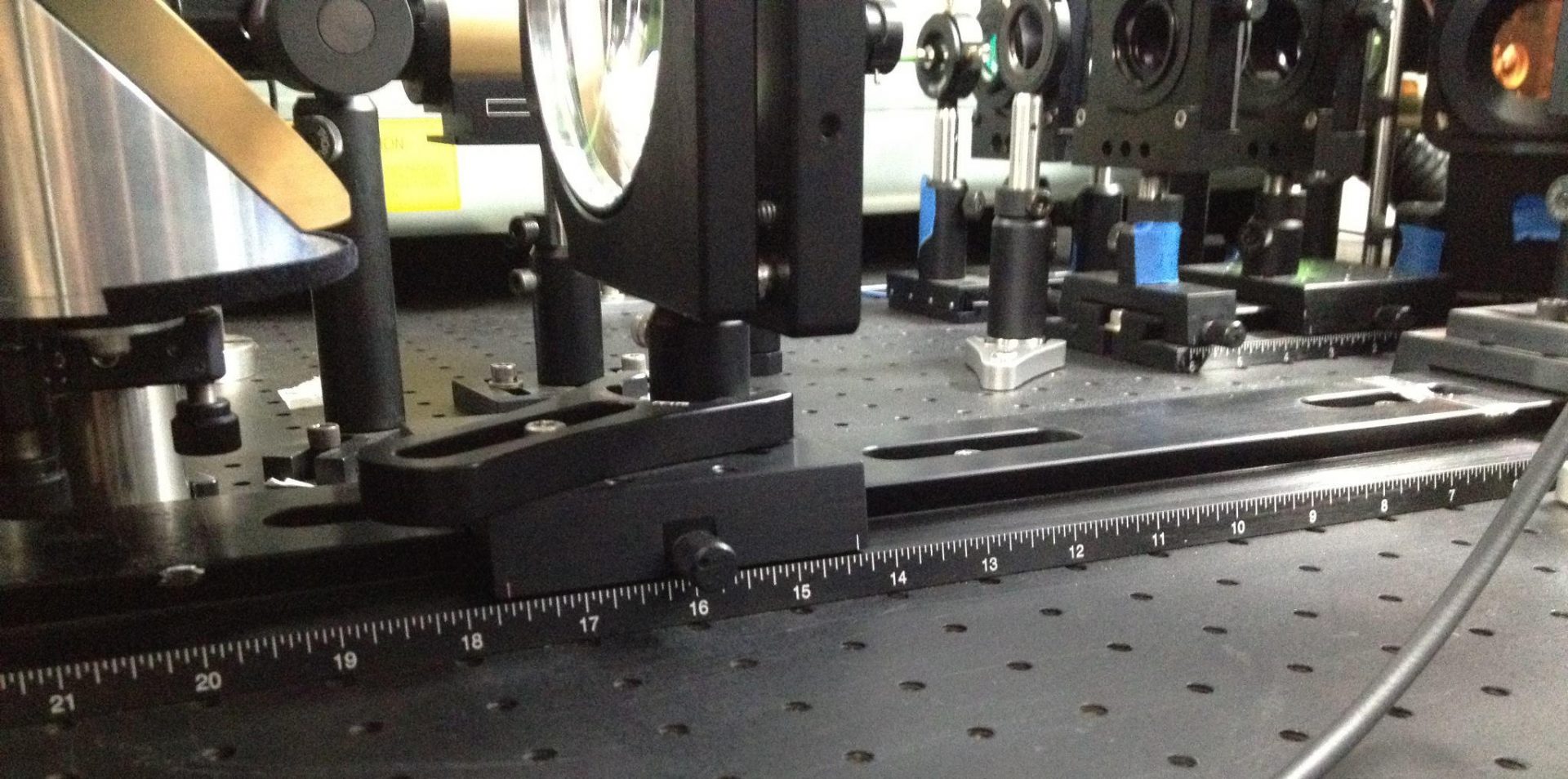I can already hear you typing angrily to me. I appreciate it, actually! You are writing about Kennedy Space Center and how it’s not on the map. You are writing about getting into orbit and how that is not too big of a deal, that all you really need is the oceanic ‘crash pad’ for launches with rockets. Ok, so, let’s go through some of the math then, yes? Oh, and if you are not interested in this stuff, that’s cool too, just skip to Chapter 2.
Ok, math time! First thing we need to talk about is the Tsiolkovsky Rocket Equation:
The symbols mean: is the final speed of the rocket when it is in orbit around the Earth. is the speed of the exhaust coming out of the rocket. ln() is the NATURAL logarithm, not the regular logarithm. is the initial mass of the rocket with all the fuel inside of it still. is the final mass of the rocket once it has used up all the fuel and is in space, circling the Earth.
Now, this rocket equation is notable in one very terrible regard, it’s exponential! That means that the heavier the rocket, the harder it is to get stuff into orbit. It’s not that a 2 lbs. payload is twice as hard to get into orbit as a 1 lbs. payload, it’s that it takes 2.7 times more fuel. And a 4 lbs. rocket takes about 20 times more fuel than a 1 lbs. payload. All because you have to haul that extra fuel up with you as you zoom into space. But that extra fuel takes fuel to haul up with you too! Pretty much, heavier things get really hard to put into space.
Ok, now the second thing we need to talk about is how fast the earth is rotating. As I mentioned in Chapter 1, that speed is about 460 m/s (the actual number is 464.58 m/s, and yes that little bit matters, this IS rocket science after all). Now, this is the speed at the equator. If you want the speed at any other latitude, then just multiply it by the cosine of the latitude. Here in Denver, we’re at 39.7⁰ North. So, the speed of the Earth is a bit lower:
We also need to know the speed that a rocket needs to go to be in orbit. Remember, orbiting is going fast enough along the surface of the Earth so that as you fall down (due to gravity), the Earth curves away from you at that same rate. This is the reason they sometimes call orbiting free fall. Because you are always falling. Also, it’s the orbital speed that takes the most energy from the rocket, just flying up above the air isn’t all that difficult. It’s that you have to go sideways fast enough so that the curvature of the Earth is the rate at which you fall. Anyways, the speed that you need to get to is about 9.7 km/s (when you factor in air-drag, vertical acceleration, etc.).
So, the speed you need for when you launch is 9.7 km/s minus the ground’s speed. However, this is for launch towards the east (one of the criteria in Chapter 1). If you wanted to launch to the west, you would ADD the ground speed to 9.7 km/s. Obviously, you want the smallest number (rocket science is a lot like golf in certain ways), so you launch to the east. Also, since you have to take the cosine of the latitude, that means as you move toward the north or south pole, you also have less ground speed to subtract. So launching at the equator is the best option.
Let’s pick out a rocket to use as an example, so that we can play with some of these numbers and get a feel for the effects of latitude. Let’s look at the Space Shuttle and use that as a basic example. The calculations I’m about to do are just for the shuttle. If you change the specifics, then you’d have to recalculate everything. Honestly, these things are pretty individual and important. But I want to give you a feel for it. Try it yourself!
Here are the basic facts of the Shuttle:
Empty weight: 78 000 kg
Gross liftoff weight: 1 995 806 kg
Payload to low Earth orbit: 24 310 kg
Exhaust Velocity: 3 586.8 m/s
Ok, now we have all the information we need to see how latitude effects the launch of the shuttle. Let’s compile this into a table and some graphs to look at the data. Let’s use some launch sites of today as latitude locations. Also, let’s look at the Mass Loss, so to speak, that you are incurring. Basically, let’s compare the ‘loss’ in payload you COULD HAVE sent up as compared to the Equator.
| Site | Latitude | Ground Speed (m/s) | Orbital Speed Needed (m/s) | Final Mass (kg) | Mass Diff. (kg) | Mass Diff (%) |
| North Pole | 90 | 0 | 9700 | 6845.88 | 946.74 | 12.15 |
| Plesetsk | 62 | 218.1 | 9481.9 | 7275.07 | 517.55 | 6.64 |
| Baikonur | 46 | 322.7 | 9377.3 | 7490.35 | 302.27 | 3.88 |
| Denver | 38.7 | 362.6 | 9337.4 | 7574.14 | 218.48 | 2.8 |
| Tanegashima | 30 | 402.3 | 9297.7 | 7658.44 | 134.18 | 1.72 |
| Cape Kennedy | 28 | 410.2 | 9289.8 | 7675.33 | 117.29 | 1.51 |
| US Virgin Islands | 10 | 457.5 | 9242.5 | 7777.21 | 15.41 | 0.2 |
| Korou | 5 | 462.8 | 9237.2 | 7788.71 | 3.91 | 0.05 |
| Equator | 0 | 464.6 | 9235.4 | 7792.62 | 0 | 0 |

Amazing! The losses aren’t really all that extreme! Launching from Kennedy only ‘costs’ you about 120 kg (about two healthy humans). However, things then to get very costly when you get to the North Pole, and you lose about 1 metric ton as opposed to launching at the Equator. Meaning that you need to take a lot more fuel to get into orbit. Also, you have to deal with polar bears, not Daiquiris. Youch!
Now, wait a second, I hear you saying, I thought that you were going to say that Equatorial launches were amazing. But this data says that it really doesn’t matter at all! Look at those percentages!
Yes, yes. The percentages are very small. Things don’t really get bad until you get up to about 45⁰ or so. However, the whole point is TRADE. In trade, even small percentages will start a war. So, let’s look at this in terms of the cost per kilogram to launch something into orbit using the space shuttle.
Here I am going to use the current NASA estimates of about $22,050/kg, Elon Musk’s promise of $2,205/kg and NASA’s goal of getting the cost down to $220/kg by the year 2070. I’ve also included at the bottom, the latitudes where the payload loss from being at a higher latitude is just one Kilogram, and where the payload loss/kg from being at a higher latitude (given the 2070 goal of $220/kg) is under $10. Remember, though, these are calculations done for the specifics of the Space Shuttle. If you want to change the rocket and vehicle, you’ll have to do the calculations yourself.
| Cost Penalty | ||||
| Site | Latitude | Today | SpaceX | 2070 Goal |
| North Pole | 90 | $20,875,617.00 | $2,087,561.70 | $208,282.80 |
| Plesetsk | 62 | $11,411,977.50 | $1,141,197.75 | $113,861.00 |
| Baikonur | 46 | $6,665,053.50 | $666,505.35 | $66,499.40 |
| Denver | 38.7 | $4,817,484.00 | $481,748.40 | $48,065.60 |
| Tanegashima | 30 | $2,958,669.00 | $295,866.90 | $29,519.60 |
| Cape Kennedy | 28 | $2,586,244.50 | $258,624.45 | $25,803.80 |
| US Virgin Islands | 10 | $339,790.50 | $33,979.05 | $3,390.20 |
| Korou | 5 | $86,215.50 | $8,621.55 | $860.20 |
| Equator | 0 | $0.00 | $0.00 | $0.00 |
| 1 kg | 2.5 | $22,050.00 | $2,205.00 | $220.00 |
| Under $10 | 0.15 | $882.00 | $88.20 | $8.80 |
Now this is why it pays, literally, to be on the equator! At today’s rates of shipping into space, even 5 degrees away from the equator results in ~$86,000 in loss when shipping on the space shuttle. Kennedy is at ~$2.5 million in lost money each launch because it is so far north. (Over it’s 30 year, 135 mission run, that was about $350 million dollars lost {about $1 per US citizen}. Granted at about $1.5 billion per shuttle launch, it wasn’t really that big of a deal, but still!)
At the very bottom is the degree of latitude where, in 2070, the launch cost per kilogram is under $10 (relative to the equator). It turns out that 0.15 degrees is about 10.3 miles (16.6 km), about a 20 minute car ride from the Equator. 2.5 degrees is about 172 miles. At this price differential, I assume that other factors should overtake the launch savings cost. For a 62 kg average human, that extra cost from not being on the equator is only $550 to get into orbit, about the price of an NYC-LA airplane ticket. Now, that isn’t really a lot, as a percentage, but even at very cheap shipping into space, it adds up pretty quickly!

